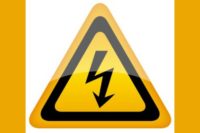Deaths due to on-the-job electrical incidents have consistently decreased in the past decade. The Bureau of Labor Statistics’ Census of Fatal Occupational Injuries (CFOI) shows a clear decline in electrical injuries during the period. In the first half (2004-2008) 1,159 fatalities occurred, and 803 workers died in the second half (2009-2013), a 31-percent decrease. Nearly all fatal injuries were electrocutions (99 percent).
What can be learned from these tragedies?
A (NIOSH student manual, “Electrical Safety, Safety and Health for Electrical Trades, Revised Edition,” describes real-life workplace accident scenarios and outlines lessons workers can learn from them. Here are a few examples:
Simple circuit tester could have saved a life
A male service technician arrives at a customer’s house to perform pre-winter maintenance on an oil furnace. The customer leaves the house and returns 90 minutes later. She notices the service truck still in the driveway. After two more hours, she goes into the crawl space with a flashlight to look for the technician but can’t find him. She calls the owner of the company, who comes straight to the house. He searches the crawl space and finds the technician on his stomach, leaning on his elbows in front of the furnace.
The assistant county coroner is immediately called and pronounces the technician dead at the scene. The victim has electrical burns on his scalp and right elbow. After the incident, an electrician inspects the site. A toggle switch that supposedly controlled electrical power to the furnace was in the “off” position. The electrician describes the wiring as “haphazard and confusing.” Two weeks later, the county electrical inspector performs another inspection. He discovers incorrect wiring of the toggle switch allowed power to flow to the furnace even when the switch was in the “off” position.
According to NIOSH, his death could have been prevented:
• The victim should have tested the circuit to make sure it was de-energized.
• Employers should provide workers with appropriate equipment and training. Using safety equipment should be a requirement of the job. In this case, a simple circuit tester may have saved the victim’s life.
• Residential wiring should satisfy the National Electrical Code (NEC). Although the NEC is not retroactive, all homeowners should make sure their systems are safe.
Ignoring OSHA
Five workers are constructing a chain-link fence in front of a house, directly below a 7,200-volt energized powerline. As they prepare to install 21-foot sections of metal top rail on the fence, one of the workers picks up a section of rail and holds it up vertically. The rail contacts the 7,200-volt line, electrocuting the worker. Following inspection, OSHA determines the employee who was killed never received any safety training from his employer and no specific instruction on how to avoid the hazards associated with overhead powerlines. In this case, the company failed to obey these regulations:
• Employers must train their workers to recognize and avoid unsafe conditions on the job.
• Employers must not allow their workers to work near any part of an electrical circuit UNLESS the circuit is de-energized (shut off) and grounded, or guarded in such a way that it cannot be contacted.
• Ground-fault protection must be provided at construction sites to guard against electrical shock.
To read more, visit www.cdc.gov/niosh/docs/2009-113/pdfs/2009-113.pdf.




